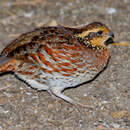en
names in breadcrumbs


The only native quail in much of its range, the Northern Bobwhite is most easily identified by its small size (8 ½ - 10 ½ inches), mottled brown body, small black bill, and short tail. Males have a white throat, white eye-stripe, and black cheek patch, while females have a more brownish head. The Northern Bobwhite inhabits a large part of the eastern United States and extreme southern Canada. Other populations occur in Mexico and the West Indies. This species is non-migratory in all parts of its range. Northern Bobwhites inhabit a variety of open habitats, including overgrown fields, forest clearings, grasslands, and scrub. Traditionally, forest fires helped create habitat for this species by removing thicker vegetation; today, human activity has a similar impact on habitat in certain areas. Northern Bobwhites mainly eat seeds and other plant material, but insects make up a higher proportion of this species’ diet in summer. Due to its preference for semi-open habitat types, Northern Bobwhites may be most easily observed foraging for food on the ground. When startled, this species may either run away or “explode” into the air and fly a short distance to safety. Northern Bobwhites are most active during the day.